Table of Contents
In this article, we’re going over a list of all the available Copilot+ laptops built on AMD Strix Point Ryzen AI 300 hardware, particularly the AMD Ryzen AI 9 HX 370, Ryzen AI 9 HX 375, and Ryzen AI 9 365 platforms available as of the second part of 2024.
The AMD Strix Point laptop platform follows up on AMD Hawk Point (Ryzen 8000) and AMD Phoenix (Ryzen 7000) and is not just a complete revamp of how the processors are branded, but also a new architecture based on AMDs latest Zen5 cores and RDNA3.5 graphics, providing a notable boost in CPU and GPU performance over the previous AMD Ryzen offers, as well as the alternatives from Intel.
Down below we’ll discuss the particularities of this hardware and how it compares to rival platforms in architecture and performance. And then we’ll go over the laptops built on Ryzen 9 AI hardware that are available today or will be in the immediate future.
At the time of this article, in the second part of 2024, three Ryzen AI 9 processors were unveiled and are offered in notebooks and tablets. Here’s a specs sheet of these options, next to their Ryzen 7000 and 8000 counterparts:
| Ryzen 9 AI HX 375 / HX 370 |
Ryzen 9 AI HX 370 |
Ryzen 9 AI 365 |
Ryzen 9 8945HS | Ryzen 9 7940HS | |
| Build process | 4nm | 4nm | |||
| Generation | Zen 5 | Zen 5 | Zen 5 | Zen 4 | Zen 4 |
| TDP | 15+ W | 15+ W | 15+ W | 35+ W | 35+ W |
| Cores/Threads | 4x Zen5, 8x Zen5c, 24 Threads |
4x Zen5, 8x Zen5c, 24 Threads |
4x Zen5, 6x Zen5c, 24 Threads |
8/16 | 8/16 |
| CPU Max Turbo | up to 5.1 GHz – Zen5, up to 3.3 GHz – Zen5c |
up to 5.1 GHz – Zen5, up to 3.3 GHz – Zen5c |
up to 5.0 GHz – Zen5, up to 3.3 GHz – Zen5c |
5.2 GHz | 4.9 GHz |
| L2+L3 Cache | 36 MB | 36 MB | 344 MB | 40 MB | 40 MB |
| Memory Type | DDR5-5600, LPDDR5x-8000 | DDR5-5600, LPDDR5x-7500 | |||
| Graphics | Radeon 890M, RDNA3.5 5nm Radeon, 16 GCores |
Radeon 880M, RDNA3.5 5nm Radeon, 12 GCores |
Radeon 780M, RDNA3 5nm Radeon, 12 EUs |
||
| Graphics Speed | up to 2900 MHz | up to 2900 MHz | up to 3000 MHz | ||
| AI Engine | NPU – up to 55 TOPS (Ryzen 375) Total – up to 85 TOPS (Ryzen 375) NPU – up to 50 TOPS (Ryzen 370) Total – up to 80 TOPS (Ryzen 370) |
NPU – up to 50 TOPS (Ryzen 365) Total – up to 73 TOPS (Ryzen 365) |
– | ||
Here’s a brief explanation of these specs:
- these Ryzen 9 AI processors are now a hybrid design, with 4x Zen5 Performance Cores, alongside 6 or 8 more efficient low-power Cores built on the Zen5c architecture. According to AMD, Zen5 cores offer a roughly 15% IPC improvement over the Zen4 cores implemented with previous platforms.
- they bundle an iGPU built on revised RDNA 3.5 Cores, with the 890M offering 16 Cores and the 880M getting 12 Cores.
- the Ryzen Ai 9 HX 375 and Ryzen Ai 9 HX 370 are identical, with minor differences in the implemented NPUs.
- the Ryzen Ai 9 365 is close to the other in CPU performance, with only two fewer Zen5c cores, but trails somewhat behind in iGPU performance, where the Radeon 880M only offers 12C graphical cores, while the Radeon 890M comes with 16 graphical cores. That means the Radeon 880M is closer in capabilities to the Radeon 780M of the previous AMD generations, which means it’s still respectable for an iGPU, but not quite a match for the 890M.
As far as power settings go, AMD gave up on having Ryzen U, HS, and HX variants of the same chip, running at different TDPs, and instead allowed the OEMs to implement these Ryzen AI 300 processors at various power levels, based on the particularities and cooling capacity of each device.
Per our tests, that means an ultraportable implementation of the Ryzen 9 AI HX 370 will run at around 28-35W sustained, while a larger laptop can run at 80W sustained. Of course, the performance differs between implementations, but even at lower power, the Ryzen AI 9 hardware is compelling.
More on that in the next section.
Ryzen AI 9 HX 370 / 365 benchmarks and performance expectations
While this is not the main topic of this article, I still want to quickly touch on the performance expectations of this Ryzen AI 9 platform compared to some of the other options available out there in full-power devices.
We do have to account for the two classes of existing Ryzen AI laptops, though, the lower-power thin-and-light models, and the full-power versions.
Here are some benchmark results on low-power 20W and 33W implementations, as well as a mid-powered 45W simulation, which are standard for portable designs of various sizes.
| Asus ProArt P16, AMD Ryzen AI 9 HX 370 + Rad 890M, 45W mode |
Asus ProArt P16, AMD Ryzen AI 9 HX 370 + Rad 890M, 20W mode |
Zenbook S 16 UM6506, AMD Ryzen AI 9 HX 370 + Rad 890M, 33W mode |
Zenbook S 16 UM6506, AMD Ryzen AI 9 365 + Rad 880M, 33W mode |
Lenovo Yoga Pro 7, AMD Ryzen AI 9 365 + Rad 880M, 25W mode |
|
| 3DMark – Fire Strike | 8706 (G – 9591, P – 26877, C – 3280) | 7553 (G – 8320, P – 20594, C – 2860) | 7505 (G – 7946, P – 25618, C – 3031) | 7585 (G – 8038, P – 24066, C – 3097) | 7925 (G – 8626, P – 23070, C – 3055) |
| 3DMark – Time Spy | 3836 (Graphics – 3462, CPU – 9903) | 3382 (Graphics – 3075, CPU – 7804) | 3598 (Graphics – 3241, CPU – 9599) | 3455 (Graphics – 3122, CPU – 8750) | 3503 (Graphics – 3164, CPU – 8944) |
| Uniengine Superposition – 1080p Extreme | 1911 | 1664 | 1600 | 1668 | 1628 |
| CineBench R23 (best run) | 19074 cb – multi core, 2002 cb – single core |
12432 cb – multi core, 2015 cb – single core |
17484 cb – multi core, 1950 cb – single core |
12823 cb – multi core, 1902 cb – single core |
13626 cb – multi core, 1956 cb – single core |
| Blender 3.01 – Classroom scene – CPU Compute | 4m 29s | 7m 00s | 5m 12s | – | 6m 41s |
| PugetBench – DaVinci After Effects | 770 | 627 | 688 | – | – |
| SPECviewperf 2020 – 3DSMax: | 45.34 | 38.56 | 40.95 | – | 39.75 |
| SPECviewperf 2020 – Catia: | 39.43 | 32.34 | 33.25 | – | 36.66 |
| SPECviewperf 2020 – Maya: | 150.32 | 130.88 | 125.32 | – | 134.45 |
For this class of computers, you have to acknowledge the single and multi-threaded performance of the CPU, but also the prowess of the Radeon 890M GPU compared to the other iGPU options available out there (Intel Arc, Radeon 780M as the best previous options).
The Ryzen AI 9 365 processor is still very competitive at low power, though, and very close to the Ryzen AU 9 HX 370 even in iGPU performance, where the power limit minimizes the gap between the Radeon 890M and 880M graphics chips.
And then there’s the CPU performance in higher-power 50W, 60W and 80W implementations.
| Lenovo Yoga Pro 7, AMD Ryzen AI 9 365 + Rad 880M, 50+W mode |
Asus ProArt P16, AMD Ryzen AI 9 HX 370 + Rad 890M, 60+W mode |
Asus Zephyrus G16, AMD Ryzen AI 9 HX 370 + Rad 890M, 80W mode |
|
| 3DMark – Fire Strike | 8835 (G – 9563, P – 28655, C – 3388) | 8947 (G – 9761, P – 29693, C – 3347) | 9042 (G – 9829, P – 30642, C – 3402) |
| 3DMark – Time Spy | 3853 (Graphics – 3462, CPU – 10712) | 3932 (Graphics – 3544, CPU – 10375) | 4043 (Graphics – 3641, CPU – 10801) |
| Uniengine Superposition – 1080p Extreme | 1809 | 1928 | 1983 |
| CineBench R23 (best run) | 19286 cb – multi core, 1966 cb – single core |
22682 cb – multi core, 2008 cb – single core |
23367 cb – multi core, 2047 cb – single core |
| Blender 3.01 – Classroom scene – CPU Compute | 5m 28s | 4m 32s | 3m 54s |
| PugetBench – DaVinci After Effects | – | 827 | 832 |
| SPECviewperf 2020 – 3DSMax: | 44.52 | 45.20 | 43.79 |
| SPECviewperf 2020 – Catia: | 40.00 | 39.94 | 37.71 |
| SPECviewperf 2020 – Maya: | 141.58 | 151.96 | 138.04 |
In this case, the Ryzen AI 9 HX 370 offers a good bump in sustained capabilities over an existing AMD Ryzen 9, Intel Core i9, or even an Intel Core Ultra 9 185H. At the same time, though, this platform is not quite made for full-performance laptops, as it trails existing Intel Core HX and Ryzen HX designs by a fair amount, due to their superior counts in Cores/Threads and their higher power implementations.
The Ryzen AI 365 comes very close in CPU performance, despite running at lower power and in a more compact chassis. The GPU capabilities of the Radeon 880M end-up within 10-15% of the Radeon 890M implementations, which is better than I was expecting based on the specs alone.
That’s why this Ryzen AI hardware is mostly available in portable all-purpose laptops such as the Asus ProArt P16, Zephyrus G16, or the MSI Stealth 16, 16-inch premium laptops around the 2 kilo mark. There will likely be updated Zen5 hardware meant for full-size performance laptops at some point, but this is not it.
With that out of the way, let’s go through the lists of notebooks built on AMD Ryzen AI 300 hardware that are available today.
2025 AMD Strix Point laptops built on AMD Ryzen AI 9 HX 370 and 365 hardware
This section lists all the available notebooks built on the AMD Ryzen AI 9 HX 370 Strix Point hardware platform, launched in 2025 or 2024. A particularity for some of the 2025 launches is upgradeable RAM with DIMM support, while the early launches all came with onboard RAM.
At the time of this article, some of these computers are ultraportable designs, compact and lightweight designs running entirely on the AMD hardware, thus on the Ryzen AI 9 processor and the Radeon 890M graphics chip.
However, most options are computers that bundle the AMD hardware with dedicated graphics chips from Nvidia. More of these should be launched in the months to come, especially once Nvidia unveils their GeForce RTX 5000 Laptop chips (sometime in 2025).
Thin-and-light options – Ryzen AI + Radeon 890M specs
We’ll first list the thin-and-light AMD-only options and follow-up with the other models below.
These are the models announced or available in stores so far. I’d expect options from Lenovo (Ideapad, Yoga lineups), MSI (Summit 16 AI+, Prestige 16 AI+) and HP to be available as well over the next few months, but there are only rumors and bits of info on these at the time of this article.
| Model | Screen | Hardware | Graphics | Weight | |
| Acer Swift 14 AI | 14-inch 16:10 OLED | up to Ryzen AI 9 HX 370, max 32 GB LPDDR5x RAM |
Radeon 890M | 3 lbs / 1.36 kg | |
| AMD Ryzen AI version of the Swift 14 AI Copilot chassis, mid-tier portable design, all-metal construction; white keyboard; good IO; OLED 3K 120Hz display; up to Ryzen AI 9 HX 370 with Radeon 890M graphics, up to 45W TDP, up to 32 GB RAM LPDDR5X, single SSD storage; ?? Wh battery, 65W USB-C charger, dual-speakers, QHD camera |
|||||
| Price: $1149 for Ryzen AI 365 specs – latest configurations | |||||
| Asus Vivobook S 14 OLED M5406 | 14-inch 16:10 OLED glossy non-touch | up to Ryzen AI 9 HX 370, max 32 GB LPDDR5x RAM |
Radeon 890M | 2.9 lbs / 1.3 kg | |
| reviewed here – mid-tier lightweight portable design, all metal chassis; RGB backlit keyboard and large glass touchpad; lots of IO; 16:10 OLED displays, either 3K 120Hz or 2K 60 Hz; several configurations up to Ryzen AI 9 HX 370 with Radeon 890M graphics, up to 54W TDP, up to 32 GB RAM LPDDR5X, single SSD storage; 75 Wh battery, 90W USB-C charger, dual-speakers |
|||||
| Price: from $1199 for Ryzen AI 365 specs – latest configurations | |||||
| Asus Vivobook S 15 OLED M5506 | 15.6-inch 16:9 OLED glossy non-touch | up to Ryzen AI 9 HX 370, max 32 GB LPDDR5x RAM |
Radeon 890M | 3.3 lbs / 1.5 kg | |
| mid-tier 15-inch lightweight portable design, all metal chassis; RGB backlit keyboard and large glass touchpad; lots of IO; 16:9 OLED display, 3K 120Hz panel; several configurations up to Ryzen AI 9 HX 370 with Radeon 890M graphics, up to 54W TDP, up to 32 GB RAM LPDDR5X, single SSD storage; 75 Wh battery, 90W USB-C charger, dual-speakers |
|||||
| Price: ?? | |||||
| Asus Vivobook S 16 OLED M5606 | 16-inch 16:10 OLED glossy non-touch | up to Ryzen AI 9 HX 370, max 32 GB LPDDR5x RAM |
Radeon 890M | 3.35 lbs / 1.52 kg | |
| mid-tier 16-inch lightweight portable design, all metal chassis; same as the S14 and S165 models, but available with a 16-inch 16:10 3.2K OLED non-touch display. |
|||||
| Price: $1199 for Ryzen AI 365 specs | |||||
| Asus Zenbook S 16 OLED UM5606 | 16-inch 16:10 OLED touch | up to Ryzen AI 9 HX 370, max 32 GB LPDDR5x RAM |
Radeon 890M | 3.3 lbs / 1.5 kg | |
| reviewed here – premium lightweight 16-inch chassis, all metal build; white keyboard with 1.1 mm travel, large glass touchpad; lots of IO; 16:10 OLED display with 3K 120Hz panel, touch; up to Ryzen AI 9 HX 370 with Radeon 890M graphics, up to 33W TDP, up to 32 GB RAM LPDDR5X, single SSD storage; 78 Wh battery, 65W USB-C charger, 6x speakers |
|||||
| Price: from $1399 for Ryzen AI 365 specs – | |||||
| Dell Pro 13 Plus or 2-in-1 | 13.3-inch 16:10 IPS matte or touch | up to Ryzen AI 9 HX 370, max 64 GB LPDDR5x RAM |
Radeon 890M | 2.77 lbs / 1.26 kg | |
| mid-tier 13-inch ultrabook, available as clamshell or 2-in-1, all-metal chassis; from 1.26 kg for the clamshell and from 1.46 kg for the 2-in-1 variants; good IO, standard keyboard, only 2K 60 Hz panels, matte or touch, multiple configurations, up to Ryzen AI 9 with 64 GB of RAM, onboard RAM, 1x SSD, 45 or 55 Wh battery, 65W adapter, 2x speakers, |
|||||
| Price: from $1349 for Ryzen AI 5 specs | |||||
| Dell Pro 14 Plus or 2-in-1 | 14-inch 16:10 IPS matte or touch | up to Ryzen AI 9 HX 370, max 64 GB LPDDR5x RAM |
Radeon 890M | 3.09 lbs / 1.4 kg | |
| 14-inch variation, same features and specs, from 1.4 kg for the clamshell and from 1.6 kg for the 2-in-1 variants; |
|||||
| Price: from $1249 for Ryzen AI 5 specs | |||||
| Dell Pro 16 Plus | 16-inch 16:10 IPS matte or touch | up to Ryzen AI 9 HX 370, max 64 GB LPDDR5x RAM |
Radeon 890M | 4.15 lbs / 1.88 kg | |
| mid-tier 16-inch all-purpose design, all-metal chassis; good IO, full keyboard with Numpad, only 2K 60 Hz panels, matte or touch, multiple configurations, up to Ryzen AI 9 with 64 GB of RAM, onboard RAM, 1x SSD, 45 or 55 Wh battery, 65W adapter, 2x speakers, |
|||||
| Price: from $1349 for Ryzen AI 5 specs | |||||
| Framework Laptop 13 | 13.5-inch 3:2 IPS matte | up to Ryzen AI 9 HX 370, max 96 GB DDR5 RAM |
Radeon 890M | 2.87 lbs / 1.3 kg | |
| mid-tier portable chassis, barebone design, all-metal construction with expansion cards for ports; white keyboard with 1.5 mm travel; good IO; 3:2 display with either 2K 60Hz or 2.8K 120Hz panels, both 100% sRGB; up to Ryzen AI 9 HX 370 with Radeon 890M graphics, up to 30W sustained TDP, up to 96 GB DDR5-5600 RAM (2x DIMMs), 1x SSD storage; single-fan, single-heatpipe, single-heatsink, phase-shift thermal compound; 61 Wh battery, 60W GaN USB-C charger, dual-speakers, FHD camera |
|||||
| Price: from $1659 for Ryzen AI 9 specs (without RAM, SSD) | |||||
| GPD Duo OLED | 14-inch 16:10 dual OLED | up to Ryzen AI 9 HX 370, max 64 GB LPDDR5x RAM |
Radeon 890M | 4.9 lbs / 2.2 kg | |
| dual-display portable laptop with a unique format, metal build; white keyboard, good IO, dual OLED displays, 13.3 inch 1600p 60Hz, with touch; up to Ryzen AI 9 HX 370 with Radeon 890M graphics, 60W TDP, up to 64 GB RAM LPDDR5X onboard, 2x SSD storage; 80 Wh battery, 100W USB-C charger, dual speakers |
|||||
| Price: ?? | |||||
| GPD Pocket 4 | 8.8-inch 16:10 IPS | up to Ryzen AI 9 HX 370, max 64 GB LPDDR5x RAM |
Radeon 890M | 1.7 lbs / .77 kg | |
| convertible laptop format, 207 x 145 mm footprint, metal build; QWERTY backlit keyboard and Hall Dual 3D joystick and touchpad, 8.8-inch 1600p 144Hz display, with touch, 100% DCI-P3 colors, 500-nits, good IO and interchangeable modules (RS-232, 4G LTE, MicroSD card reader, KVM) up to Ryzen AI 9 HX 370 with Radeon 890M graphics, 28W TDP, 64 GB RAM LPDDR5X onboard, M.2 2280 SSD storage; 45 Wh battery, 100W USB-C charger, dual speakers |
|||||
| Price: $1350 USD for Ryzen AI 9 model, on Indiegogo | |||||
| GPD Win 4 | 6-inch 16:9 IPS | up to Ryzen AI 9 HX 370, max 32 GB LPDDR5x RAM |
Radeon 890M | 1.32 lbs / .6 kg | |
| gameheld format with sliding screen and keyboard, metal build; QWERTY backlit keyboard and joysticks, good IO, optional 4G, 6-inch 1080p 60Hz display, with touch; up to Ryzen AI 9 HX 370 with Radeon 890M graphics, 35W TDP, up to 32 GB RAM LPDDR5X onboard, M.2 2280 SSD storage; 45 Wh battery, 65W USB-C charger, dual speakers |
|||||
| Price: $1150 USD for Ryzen AI 9 model, on Indiegogo | |||||
| GPD Win Mini | 7-inch 16:9 IPS | up to Ryzen AI 9 HX 370, max 64 GB LPDDR5x RAM |
Radeon 890M | 1.22 lbs / .555 kg | |
| ultra compact laptop format, 170 x 100 mm footprint, metal build; QWERTY backlit keyboard and Hall Dual 3D joystick and touchpad, good IO, 7-inch 1080p 120Hz display, with VRR and FreeSync Premium, touch; up to Ryzen AI 9 HX 370 with Radeon 890M graphics, 35W TDP, up to 64 GB RAM LPDDR5X onboard, M.2 2280 SSD storage; 44 Wh battery, 100W USB-C charger, dual speakers |
|||||
| Price: $1400 USD for Ryzen AI 9 model, on Indiegogo | |||||
| Lenovo Yoga Pro 7 14 | 14.5-inch 16:10 OLED | up to Ryzen AI 9 365, max 32 GB LPDDR5x RAM |
Radeon 880M | 3.4 lbs / 1.54 kg | |
| reviewed here – mid-range higher-power portable laptop, metal build, Luna Grey color; excellent IO, 14.5″ 2.8K OLED display; up to Ryzen AI 9 365 with Radeon 880M graphics, up to 32 GB RAM LPDDR5X onboard, single SSD storage; dual-fan cooling; 84 Wh battery for 2025 model, 100W USB-C charger, 4x speakers, 2MP IR camera |
|||||
| Price: from $1299 – | |||||
| Lenovo ThinkBook 16 G7+ | 16-inch 16:10 IPS | up to Ryzen AI 9 365, max 32 GB LPDDR5x RAM |
Radeon 880M | 4.2 lbs / 1.9 kg | |
| business laptop, ThinkBook design; excellent IO, IPS 3.2K 165Hz display, matte, ThinkBook keyboard; up to Ryzen AI 9 365 with Radeon 880M graphics, up to 32 GB RAM LPDDR5X onboard, dual SSD storage; dual-fan cooling; 85 Wh battery, 100W USB-C charger, 2x speakers, 2MP IR camera |
|||||
| Price: from $999 – | |||||
| Lenovo ThinkPad P14s | 14-inch 16:10 OLED or IPS | up to Ryzen AI 9 HX Pro 370, max 96 GB DDR5 RAM |
Radeon 890M | 3.06 lbs / 1.39 kg | |
| business workstation portable laptop, ThinkPad design and keyboard; excellent IO, 2.8K OLED or 2K IPS displays, matte or touch; up to Ryzen AI 9 HX Pro 370 with Radeon 890M graphics, up to 96 GB RAM DDR5, 2x RAM slots, single SSD storage; 52.5 or 57 Wh battery, 65W USB-C charger, 2x speakers, 5MP IR camera |
|||||
| Price: from $1199 – | |||||
| Lenovo ThinkPad P16s | 16-inch 16:10 OLED or IPS | up to Ryzen AI 9 HX Pro 370, max 96 GB DDR5 RAM |
Radeon 890M | 3.77 lbs / 1.71 kg | |
| business workstation portable laptop, ThinkPad design and keyboard; larger 16 inch version of the P14s, with 4K OLED or IPS matte displays, larger keyboad with NumPad, higher power settings, larger cooling and up to 86Wh battery |
|||||
| Price: from $1299 – | |||||
| Lenovo ThinkPad T14s | 14-inch 16:10 IPS | up to Ryzen AI 9 HX Pro 370, max 64 GB LPDDR5x RAM |
Radeon 890M | 2.86 lbs / 1.3 kg | |
| Business portable laptop, ThinkPad design, more basic and slimmer and lighter than the P14s; excellent IO, IPS displays, matte or touch, ThinkPad keyboard; up to Ryzen AI 9 PRO with Radeon 890M graphics, up to 64 GB RAM LPDDR5X, single SSD storage; 58 Wh battery, 65W USB-C charger, 2x speakers, 5MP IR camera |
|||||
| Price: from $1399 – | |||||
| HP OmniBook Ultra 14 | 14-inch 16:10 IPS | up to Ryzen AI 9 HX 365, max 16 GB LPDDR5x RAM |
Radeon 890M | 3.5 lbs / 1.6 kg | |
| mid-range portable laptop, metal build; white keyboard, limited IO, IPS touch display, 2.2K panel with 100% sRGB; up to Ryzen AI 9 HX 375 with Radeon 890M graphics, up to 16 GB RAM LPDDR5X onboard, single SSD storage; dual-fan cooling; 78 Wh battery, 65W USB-C charger, dual speakers, 9MP IR camera |
|||||
| Price: from $1379 for Ryzen AI 365 specs – latest configurations | |||||
| MSI Prestige 16 AI+ OLED | 16-inch 16:10 OLED or IPS touch | Ryzen AI 9 365, max 32 GB LPDDR5x RAM |
Radeon 880M | 4.2 lbs / 1.9 kg | |
| premium and lightweight clamshell 16-inch chassis, metal build; 16-inch touch display, 4K OLED 60Hz or QHD+ IPS 165Hz panels; an update of the existing Prestige 16 models, with AMD Ryzen AI 365 hardware and updated display options; 82Wh battery, 100W USB-C charger |
|||||
| Price: from $1399 – latest configurations | |||||
| MSI Summit 16 AI+ | 16-inch 16:10 IPS touch | Ryzen AI 9 365, max 32 GB LPDDR5x RAM |
Radeon 880M | 4.7 lbs / 2.1 kg | |
| premium and lightweight 2-in-1 convertible 16-inch chassis, metal build; convertible variant of the Prestige 16 models, with AMD Ryzen AI 300 hardware and a QHD+ 165Hz IPS touch display; 82Wh battery, 100W USB-C charger |
|||||
| Price: from $1499 – latest configurations | |||||
| TUXEDO InfinityBook Pro 14 | 14-inch 16:10 IPS 2.8K 120Hz matte | Ryzen AI 9 HX 370, max 128 GB DDR5x RAM |
Radeon 890M | 3.2 lbs / 1.45 kg | |
| 14-inch portable laptop, metal build; white keyboard; glass touchpad; lots of ports; 16:10 IPS with 2.8K 120Hz 100% sRGB panel, matte, 180 hinge; several configurations, up to Ryzen AI 9 HX 370, up to 128GB RAM DDR5X, 2x RAM, 2x SSD storage; dual-fan dual-vent cooling with heatpipes; 2x speakers 80 Wh battery, 150W USB-C charger |
|||||
| Price: from 1400 EUR for Ryzen AI 9 model | |||||
| XMG Evo 14 | 14-inch 16:10 IPS 2.8K 120Hz matte | Ryzen AI 9 HX 370, max 96 GB LPDDR5x RAM |
Radeon 890M | 3.15 lbs / 1.42 kg | |
| 14-inch mid-range portable laptop, metal build, barebone design; white keyboard; glass touchpad; lots of ports; 16:10 IPS with 120Hz 100% sRGB panel, matte, 180 hinge; several configurations, up to Ryzen AI 9 HX 370 (60W sustained), up to 96 GB RAM LPDDR5X, 2x SSD storage; dual-fan dual-vent cooling with heatpipes; 2x speakers 80 Wh battery, 100W USB-C charger |
|||||
| Price: tba in Q1 2025 | |||||
| XMG Evo 15 | 15.3-inch 16:10 IPS 2.5K 240Hz matte | Ryzen AI 9 HX 370, max 96 GB LPDDR5x RAM |
Radeon 890M | 3.8 lbs / 1.72 kg | |
| 15-inch mid-range portable laptop, metal build, barebone design; white keyboard, full-layout with NumPad; glass touchpad; lots of ports; 16:10 IPS with 240Hz 100% sRGB panel, 180 hinge; several configurations, up to Ryzen AI 9 HX 370 (60W sustained), up to 96 GB RAM LPDDR5X, 2x RAM, 2x SSD storage; dual-fan dual-vent cooling with heatpipes; 2x speakers 99.8 Wh battery, 100W USB-C charger |
|||||
| Price: tba in Q1 2025 | |||||
We’re constantly updating this list.
Let us know in the comments section if there’s a newer launch that should be in here as is not yet.
More powerful options – Ryzen AI + Nvidia RTX specs
And this section lists all options with AMD Ryzen AI 300 processors and dedicated graphics (for now, Nvidia RTX 4000 chips).
Other performance laptops built on Strix Point hardware have been taunted and rumored, including an MSI Alpha 17 and a Titan 18, but we don’t know enough about these to include them yet. We’re updating the list as it goes.
| Model | Screen | Hardware | Graphics | Weight | |
| Asus ProArt PX13 HN7306 | 13.3-inch 16:10 OLED touch | Ryzen AI 9 HX 370, max 32 GB LPDDR5x RAM |
up to RTX 4070 80W ??, without MUX | 3.05 lbs / 1.4 kg | |
| premium compact 2-in-1 design, all metal chassis; white backlit keyboard and glass touchpad; lots of IO; 16:10 OLED display with 3K 60Hz panel, with touch and pen support; several configurations, Ryzen AI 9 HX 370 with Nvidia GeForce RTX 4050, 4060 or 4070 Laptop dGPU (up to 115W CPU+GPU power), up to 32 GB RAM LPDDR5X onboard, single SSD storage; dual-fan quad-exhaust cooling design, liquid metal; 73 Wh battery, 135W USB-C charger, dual-speakers |
|||||
| Price: from $1699 for RTX 4050 model – | |||||
| Asus ProArt P16 H7606 | 16-inch 16:10 4K 60 Hz OLED touch | Ryzen AI 9 HX 370, max 64 GB LPDDR5x RAM |
up to RTX 4070 100W, without MUX | 4.1 lbs / 1.85 kg | |
| reviewed here – premium 16-inch creator design, all metal black chassis; white backlit keyboard and large glass touchpad; lots of IO; 16:10 OLED display with 4K 60Hz panel, with touch and pen support; several configurations, Ryzen AI 9 HX 370 with up to Nvidia GeForce RTX 4070 Laptop dGPU (up to 120W CPU+GPU power, without MUX), up to 64 GB RAM LPDDR5X onboard, 2x SSD storage; tri-fan quad-exhaust cooling design, liquid metal; 90 Wh battery, 200W charger, 6x speakers |
|||||
| Price: from $1899 for RTX 4060 model – | |||||
| Asus ROG Zephyrus G14 GA403W | 14-inch 16:10 2.8K 120Hz OLED glossy non-touch | Ryzen AI 9 HX 370, max 64 GB LPDDR5x RAM |
up to RTX 5080 110W, with MUX | 3.5 lbs / 1.55kg | |
| premium 14-inch all-purpose and gaming laptop, all metal chassis in silver or grey; slightly thicker and heavier than the 2024 G14 model, but more powerful; RGB keyboard and large glass touchpad; lots of IO; 14-inch 16:10 OLED display with 2.8K 120Hz panel, with GSync; several configurations, up to Ryzen AI 9 HX 370 with up to Nvidia GeForce RTX 5080 16GB Laptop dGPU (up to 110W TGP), up to 64 GB RAM LPDDR5X onboard, single M.2 SSD storage; tri-fan cooling design, liquid metal; 90 Wh battery, 200W charger, 6x speakers |
|||||
| Price: tba in Q1 2025 | |||||
| Asus ROG Zephyrus G16 GA605W | 16-inch 16:10 2.5K 165Hz OLED glossy non-touch | Ryzen AI 9 HX 370, max 32 GB LPDDR5x RAM |
up to RTX 4070 100W, with MUX | 4 lbs / 1.8 kg | |
| reviewed here in Ryzen 9 + RTX 4060 and Ryzen 9 + RTX 4070 variants, premium 16-inch all-purpose and gaming laptop, all metal chassis in silver or grey; RGB backlit keyboard and large glass touchpad; lots of IO; 16:10 OLED display with 2.5K 165Hz panel, with GSync; several configurations, Ryzen AI 9 HX 370 with up to Nvidia GeForce RTX 4070 Laptop dGPU (up to 120W CPU+GPU power, with MUX), up to 32 GB RAM LPDDR5X onboard, 2x SSD storage; there’s also a 2025 updated G16 with RTX 5070 graphics, but that comes with a Ryzen 7 AI Krackan Point processor, tri-fan quad-exhaust cooling design, liquid metal; 90 Wh battery, 200W charger, 6x speakers |
|||||
| Price: from $1899 for RTX 4060 model – | |||||
| Asus TUF Gaming A14 FA401 | 14-inch 16:10 2.5K 165Hz IPS matte | Ryzen AI 9 HX 370, max 32 GB LPDDR5x RAM |
up to RTX 4060 100W, with MUX | 3.22 lbs / 1.46 kg | |
| mid-tier 14-inch all-purpose compact laptop, part metal chassis; RGB backlit keyboard and glass touchpad; lots of IO; 16:10 IPS display with 2.5K 165Hz 100% DCI-P3 matte panel, with GSync; several configurations, Ryzen AI 9 HX 370 with up to Nvidia GeForce RTX 4060 Laptop dGPU (up to 120W CPU+GPU power, with MUX), up to 32 GB RAM LPDDR5X onboard, 2x SSD storage; dual-fan dual-exhaust cooling design; 73 Wh battery, 200W charger, dual speakers |
|||||
| Price: from ?? for RTX 4050 model – | |||||
| Asus TUF Gaming A16 FA608 | 14-inch 16:10 IPS 2.5K 165Hz matte | Ryzen AI 9 HX 370, max 32 GB LPDDR5x RAM |
up to RTX 4070 140W, with MUX | 4.85 lbs / 2.2 kg | |
| mid-tier 16-inch all-purpose laptop, refresh of existing TUF A16 model, part metal chassis; RGB backlit keyboard; lots of IO; 16:10 IPS display with 2.5K 165Hz 100% sRGB panel, with GSync; several configurations, Ryzen AI 9 HX 370 with up to Nvidia GeForce RTX 4070 Laptop dGPU (up to 140W CPU+GPU power, with MUX), up to 32 GB RAM LPDDR5X onboard, 2x SSD storage; dual-fan cooling design with full-length rear heatsink; 90 Wh battery, 240W charger, dual speakers |
|||||
| Price: from $1499 for RTX 4060 model – latest configurations | |||||
| Gigabyte Aero X16 | 16-inch 16:10 IPS 2.5K 165Hz matte | up to Ryzen AI 9 HX 370, max 64 GB DDR5 RAM |
up to RTX ?? | 4.2 lbs / 1.9 kg | |
| slim lightweight 16-inch creator laptop, metal build, available in gray or white; IPS QHD 165Hz display with 100% sRGB; single-zone RGB keyboard; AMD Ryzen AI 300 hardware and RTX 5000 graphics, 2x RAM, 2x SSD; 76Wh battery, 150W USB-C charger, 2x speakers. |
|||||
| Price: – | |||||
| MSI Creator 16 AI+ | 16-inch 16:10 IPS matte | up to Ryzen AI 9 HX 370, max ?? RAM |
up to RTX ?? | 4.4 lbs / 2 kg | |
| premium and lightweight 16-inch creator laptop, magnesium alloy build; IPS touch display; an update of the existing Creator 16 models, with AMD Ryzen AI 300 hardware and RTX graphics, 2x RAM, 2x SSD; to be updated |
|||||
| Price: ?? | |||||
| MSI Stealth A16 AI+ | 16-inch 16:10 IPS 2.5K 240Hz matte | up to Ryzen AI 9 HX 370, max 32 GB LPDDR5x RAM |
up to RTX 5090 115W, with MUX | 4.6 lbs / 2.1 kg | |
| premium and lightweight 16-inch creator laptop, metal build; IPS QHD 240Hz display; RGB keyboard; 2025 updated specs with AMD Ryzen AI 300 hardware and RTX 5000 graphics, onboard RAM, 2x SSD; 99Wh battery, 240W charger, 6x speakers. |
|||||
| Price: – | |||||
| MSI Stealth A18 AI Studio | 18-inch 16:10 IPS or miniLED matte | up to Ryzen AI 9 HX 370, max 64 GB LPDDR5x RAM |
up to RTX 4090 150W, with MUX | 6.9 lbs / 2.9 kg | |
| premium and lightweight 18-inch creator laptop, metal build; IPS QHD 240Hz or mini LED 4K 120Hz display; RGB keyboard; various configurations, with AMD Ryzen AI 300 hardware and up to RTX 5090 graphics, 2x RAM, 2x SSD; vapor-chamber cooling; 99Wh battery, 280W charger, 6x speakers. |
|||||
| Price: – | |||||
| Razer Blade 16 | 16-inch 16:10 OLED 2.5K 240Hz glossy | Ryzen AI 9 HX 370, max 64 GB LPDDR5x RAM |
up to RTX 5090 155W, MUX | 4.85 lbs / 2.2 kg | |
| new premium 16-inch all-purpose laptop, metal build, ultra-thin design; per-key RGB backlit keyboard; good IO; 16:10 OLED display with 2.5K 240Hz 100% DCI-P3 panel, with GSync; several configurations, Ryzen AI 9 HX 370 with up to Nvidia GeForce RTX 5070 24GB Laptop dGPU (up to 155W TGP ??), up to 64 GB RAM LPDDR5X onboard, 2x SSD storage; updated vapor-chamber cooling with rear heastsinks; 6x speakers 90 Wh battery |
|||||
| Price: tba in Q1 2025 | |||||
That’s about it for this article.
But as mentioned already, stay around, we’re constantly updating these lists of laptops built on AMD’s Strix Point Ryzen AI 300 platforms, adding new launches as they are released. We’ve also discussed the more recent AMD platforms in separate articles, such as this one that goes over AMD Strix Halo and AMD Krackan hardware.


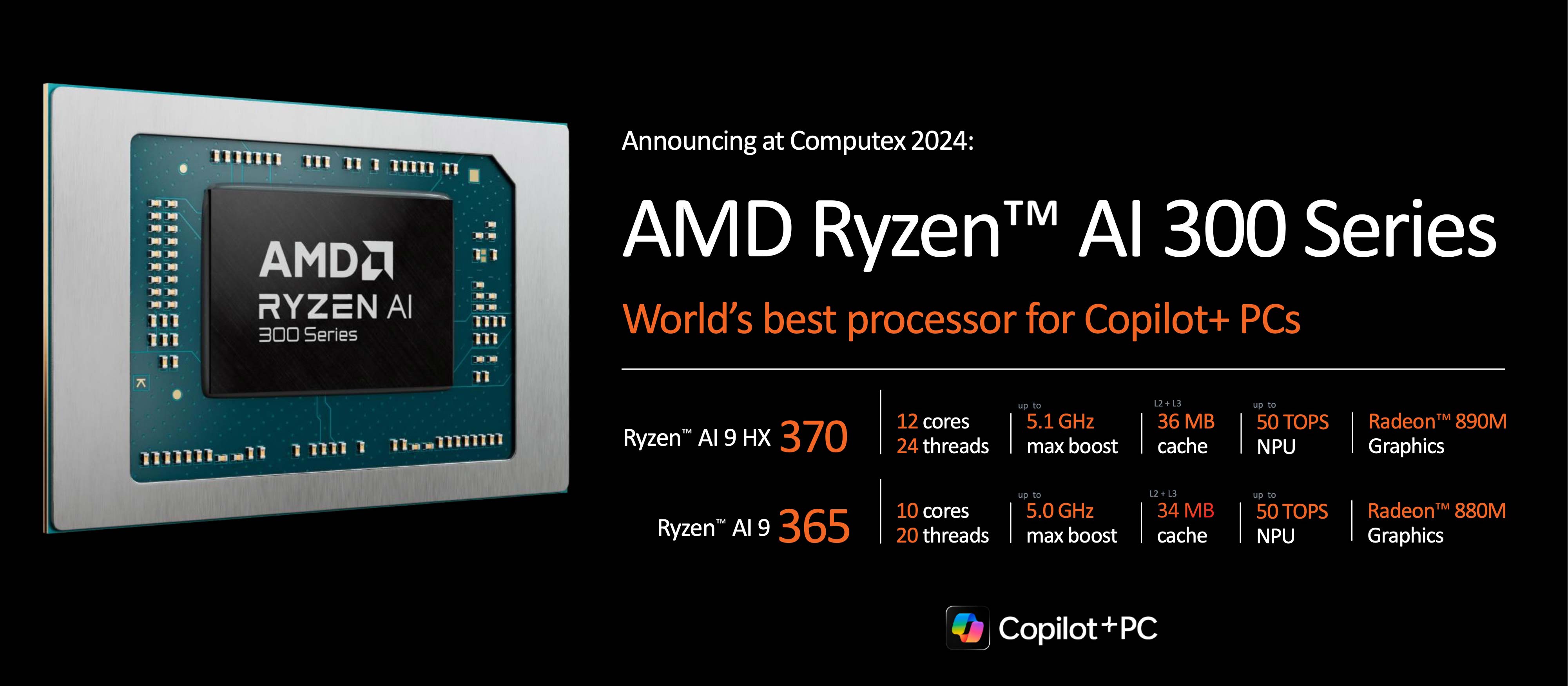


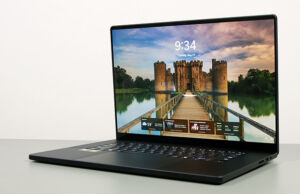


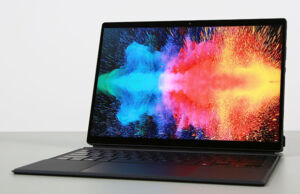
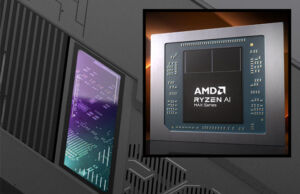
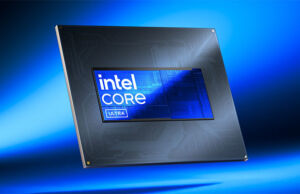
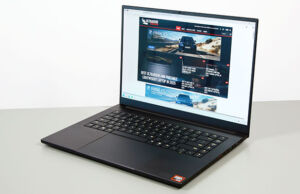

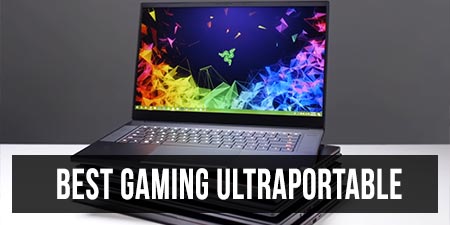
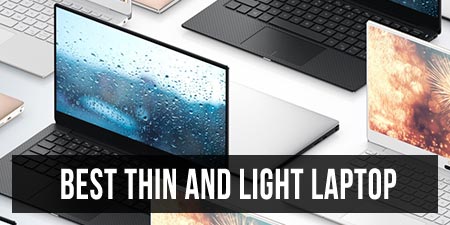
Solder Deez Nuts
September 2, 2024 at 6:03 pm
Why do none of these laptops have upgradeable RAM? AMD clearly supports DDR5-5600, yet all the laptop manufacturers are using soldered LPDDR5. Infuriating.
Waiting for a Framework laptop with this CPU
Andrei Girbea
September 2, 2024 at 6:22 pm
Get used to it. Soldered RAM is going to be the norm with the latest hardware platforms
NikoB
September 5, 2024 at 6:19 pm
This looks like a complete mockery of buyers, especially considering that AMD claims support for up to 256GB of RAM in 2 slots in Zen4 Phoenix+. Although in the professional sector there are already models with soldered 64GB, this is still a bad and dangerous trend in general. When you can’t buy a cheap laptop with a minimum amount of memory from the factory, saving a lot, which always comes at a price several times higher than the same models in retail, and with a 5-10 year warranty.
Apparently, the new draconian trend from manufacturers (almost like a conspiracy) wants to make most laptops disposable.
On the one hand, soldered memory should provide advantages in speed and platform stability (in practice, the difference is small), on the other hand, a large mass of novice professionals and students will now be forced to change the entire laptop, instead of immediately installing a cheap model with 64 or more slots, where the memory controller supports it. Or buy obviously very expensive variants with 64GB or more. Now you can still easily buy a laptop with 16 (and even one 8GB module) and buy 32+32 cheaply. Which is what many professionals do right after buying a laptop.
Soldered memory is also bad because if literally one chip fails, you will have to change the entire motherboard with a soldered processor and other components. And this is 60%+ of the laptop price. Resoldering a module is not a very reliable solution and not cheap outside the warranty period.
And if they also start soldering SSDs like Apple, especially QLC, then I don’t even know what future buyers should do.
Now, most workers and students who need to spend many hours in front of the screen for business (and not hipsters in cafes) will have almost no choice, as well as the sad advent of a priori harmful to the eyes AMOLED (OLED) panels, which absolutely all without exception flicker at a frequency significantly less than 1.25kHz (until now, most AMOLED (OLED) panels have a PWM below 250Hz and there are generally terrible models with 60Hz), which is considered minimally safe according to the international standard IEEE PAR1789.
In addition, they are glossy and wildly glare and have a significantly lower burn-in resource of up to 50% of the brightness level and color stability than typical IPS with a backlight resource of IPS at least 15k hours (in practice, much more).
From 2025, in fact, a forced transition of most laptops to AMOLED and soldered memory is coming. This is evident from your tables of new models. Approximately as in smartphones there are practically no cool variants in 2024 with IPS panel safe for eyes and 4k@60fps+ video recoding.
The world of technology has been clearly changing in the wrong direction in recent years, despite the growing ergonomic and security problems of devices. It's as if all manufacturers have forgotten who they are important for in the first place…
Richard
September 6, 2024 at 4:25 pm
If Framework do a version with these processors it will not have soldered memory so we have that option at least and we can leave soldered RAM to the unknowing victims who will buy a 16GB laptop in 2024/25.
Niko is not quite right, in that I've seen quite a few videos of memory upgrades recently where the inexpensive chips are bought off of Aliexpress and double the memory is added to the device that's upgraded so it's possible to fix/upgrade a laptop with soldered memory.
Camo5
September 13, 2024 at 4:51 pm
I just hope the adoption of LPCAMM2 is closer around the corner than we think, considering it's been almost a year since it was first unveiled at this point.
I'm holding my breath until the first mfg makes a 16" 100wh laptop with 256-bit LPCAMM2 config using the 40CU strix Halo APU.
Richard
September 18, 2024 at 3:43 pm
I specifically tweeted at Framework about this combination when I put the two together in my head back in April.
Skrunkly Bungus
November 25, 2024 at 12:50 am
GPD Pocket 4 just dropped my dudes
will blake
January 30, 2025 at 10:24 pm
Thinking between Vivobook 16 and Thinkbook 16. The latter seems almost perfect for me but 365 only pisses me off.
Jeremiasz
February 26, 2025 at 9:48 pm
Hello, according to pfron (thinkpad specifications), the T14 gen 6 is only going to have 360 CPU with 880M graphics. Huge bummer for me, and I kindly ask to change the specs in the list… Someone else can inhale the hopium and be as mad as I am now.
Anyways, thank you for the article, fantastic read and I hope to see more ThinkPads!
Eric
March 12, 2025 at 12:42 am
You should update the list adding the Framework, it's now possible to get it with ryzen ai 9 (in preorder, but still)
Andrei Girbea
March 12, 2025 at 10:29 am
Thanks. Done!
Nik
June 17, 2025 at 9:35 am
Consider adding TUXEDO InfinityBook Pro 14 – Gen10 to the list.